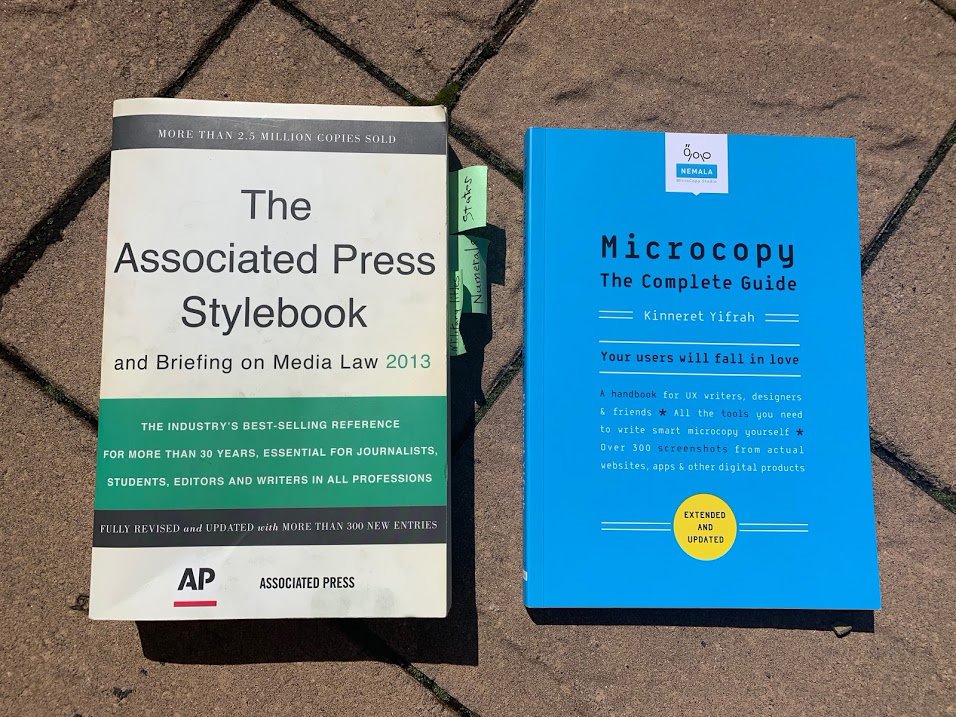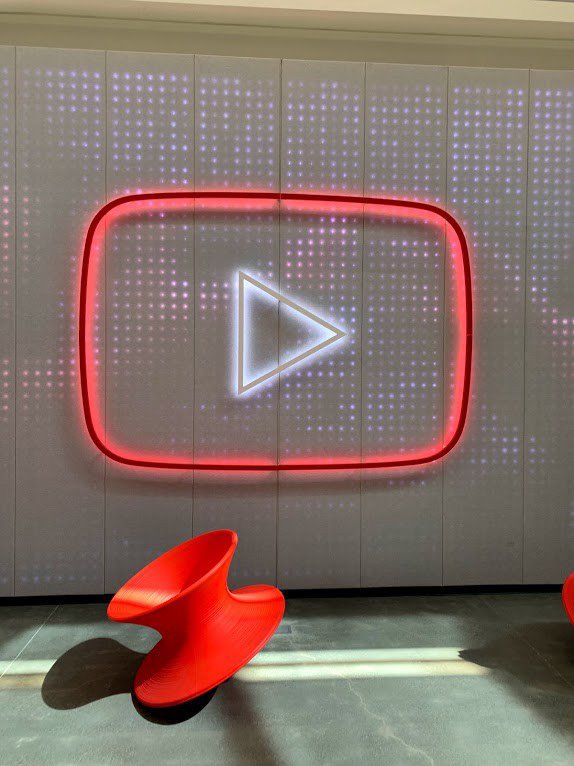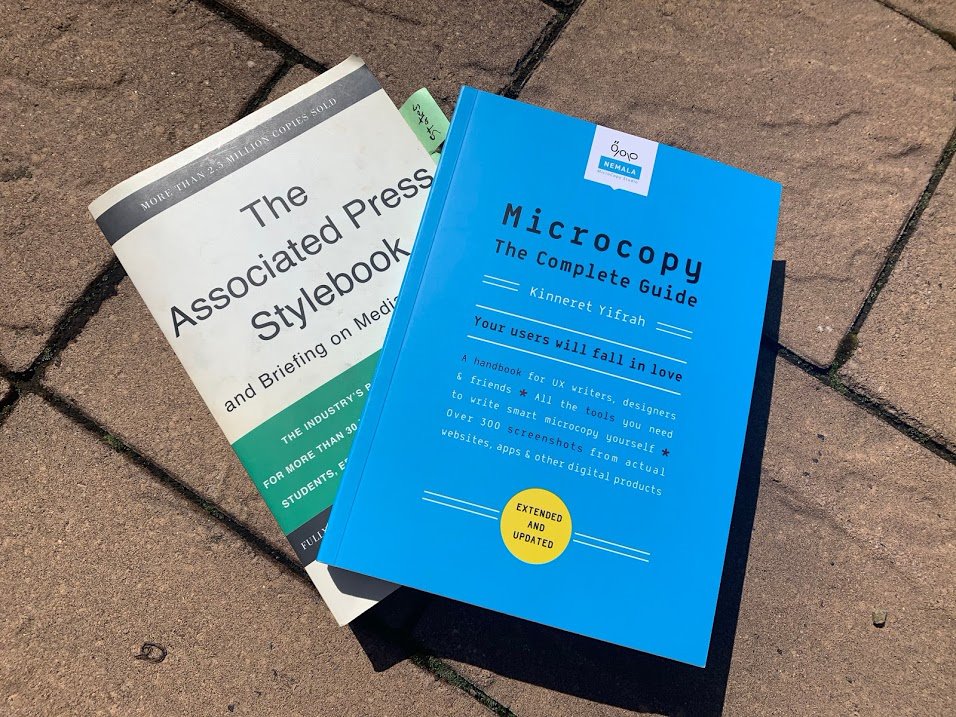
Journalists mainly follow the Associated Press Stylebook, left, to help sharpen their writing. UX writers similarly ensure that product copy follows a content style guide and maintain it.
— PUBLICATION NAME
Medium
— SUMMARY
How UX writing and journalism are more similar than people think
— PUBLISHED ON
April 7, 2020
I published a Medium article, titled "How A Journalism Background Can Benefit UX Writing" where I detailed my personal journey of starting out in journalism before becoming enamored by UX writing.
Little did I realize that many journalistic skills and principles can apply to UX writing. And I love it.
For over a decade, I dreamed of becoming a journalist so I can write stories to enlighten the greater society, which seemed like a noble and idealistic cause. I even had this fantasy of working as an editor in a major culture or entertainment magazine in a metropolitan city.
Since I began pursuing journalism in college and writing for numerous publications in 2014, I’ve felt that my dream to be a big-city editor was finally within reach, but something happened.
Throughout my college days, my professors often half-jokingly warned us students that becoming journalists will not be an easy path. While my dream still nagged at me to not give up, I began encountering the harsh realities of the journalism industry after I graduated and began working at a local weekly newspaper.
As people have shorter attention spans in our hyper-technological society, they don’t pick up physical newspapers or want to subscribe to a publication as much anymore. It’s because many prefer to read stories online or even on social media, which they perceive as being much more convenient.
There has been a dangerous movement where journalism gets bashed by politicians and everyday folks for being “fake news,” sensational or a thing of the past.
These factors have caused the journalism industry to shrink in recent years and struggle to stay afloat financially.
It also caused my dream to start fading in 2018, unfortunately. But I realized that my passion for journalism was actually the one that was crumbling away, not my passion for writing.
So, I began wondering, “What do I do now?”
That’s when I first heard of UX writing.
UX says hello.

A private tour of the YouTube/Google offices in San Bruno, California led to an epiphany.
I have a slightly younger brother who is studying to become a UX Designer and he has managed to land highly-coveted summer internships at Microsoft and Google.
He often mentioned to me how much he enjoyed collaborating with fellow UX designers to work on user personas, use design tools like Figma and Sketch to bring a product to life, practice information hierarchy and etc.
“Well, there’s UX writing,” my brother said casually, initially not noticing my puzzled expression.
After asking him more about it, he explained the fundamental basics of UX writing and how it was a rising field that not many people are even aware of yet. And I was one of those people.
This prompted me to fall into a rabbit hole of extensive research into the field. I also then took a leap of faith and enrolled in several online UX writing courses to learn more, develop my skills and network with both UX writers in the field and fellow hopeful UX writers-to-be.
Among the exemplary courses I’ve taken include the UX Writers Collective Fundamentals course in fall 2019 and the UX Writing Hub in spring 2020.
Perhaps this was the answer!
Skills not gone to waste.

As a journalist, I’ve gained a valuable palette of skills, particularly because journalists today must juggle multiple duties — writing, copy editing, photographing, print layout design, web editing and audio/video editing.
I’ve also learned to:
- - Determine what stories are newsworthy
- - Dig into the social/emotional issue at the core of a story if possible (to make them relatable)
- - Conduct research
- - Approach an event or situation from multiple story angles
- - Asking the right questions
- - Build a network of sources
- - Break down complicated information
- - Write in concise copy
- - Write to an audience (readers and subscribers, in this case) and keep them in mind
- - Ensure the information is presented in an organized and easy-to-digest manner
But as I continued learning and researching about UX writing, I realized that many of the aforementioned skills can definitely still apply.
In UX writing, the UX writer strives to inform the user quickly why a certain app, product, website or service can help them achieve their goal (checking the weather, ordering food online, handling money transactions, etc.).
If the user believes it could indeed help achieve their goal, they’re more likely to give it a try and if it’s a positive experience, they’re even more likely to return, become a loyal supporter or spread good word of mouth.
A UX writer also needs to do research like conducting:
- - Competitive analysis — to see how other similar businesses operate both -successfully and unsuccessfully
- - Conversation mining — looking into how people talk about a certain app/product/website/service online, noting commonly-used words/phrases, etc.
- - User interviews — asking careful questions that reveal a person’s perception of your hypothetical app/website/service, having their expectations met, what those expectations are, how they feel about specific copy, etc.
- - User personas — identifying and keeping in mind who your app/website/product/service would ideally cater to
Overall themes like collecting information, using it to inform the (UX or journalism) writing process and presenting the final product in a concise and easy-to-understand are reasons why journalism and UX writing skills can blend well.
A story, a user experience, a journey.

In journalism, the general writing hierarchy is: headline → subheading → lead → nut graf → the remainder of the story and further background information.
In essence, a reader wants to immediately know what the story is about (headline), have some much-needed context (subheading), the who/what/when/where/how/why of the story (lead/nut graf) and feel more informed about the story’s background (remainder of the story).
Even having a visual (a photo, video, etc.) between the headline/subheading and the story’s text helps to visualize the information to the reader.
This writing-visual hierarchy applies regardless of whether the user is reading the story online or in print.
So what about it, you ask?
It’s that you make sure the reader gets informed quickly without causing cognitive burden. It’s also about using visual hierarchy to tell the whole story within an ideal 10-second timeframe, just by looking at the headline, subheading, visual and the lead.
In UX writing, information architecture is key because a UX writer strives to determine what information (and visuals?) needs to be immediately shown to the user, as well as how to present that information concisely.
This is why UX writing places a heavy emphasis on clear and concise copy, so users don’t feel overwhelmed with too much copy or jargon.
Copy editing and reducing the number of words in a story (without “dumbing” the story down or leaving essential information out) are key skills in journalism too.
Information architecture starts to blend into UX design and that’s why UX writing is such a collaborative field.
UX writers, depending on their company’s size, must work with various stakeholders, including UX designers, department heads, product marketers and more.
Never go out of style.

In journalism, the Associated Press Stylebook (AP Style) is the leading style reference guide for many publications.
AP Style outlines grammar, spelling and punctuation guidelines that reporters use in their writing. Deviating from AP Style is one way to distinguish a reporter from say, a creative writer, a novelist or a technical writer.
As the world continues to evolve technologically and culturally, the AP Stylebook is constantly updated to keep up with the times.
For instance, the original first public edition was released in 1953. Since then, significant changes and movements have affected the way we live, including the internet, social media, a rise in television and computer programming. This has caused the AP Stylebook to include new spelling, grammar and punctuation guidelines if a reporter writes about those subjects — like determining that reporters should spell “website” and not “web site.”
In UX writing, depending on your company’s size and the product you work on, a UX writer is in charge of creating a content style guide, maintaining it and ensuring the overall company, team or product follows it.
This is important as it helps to establish a company or product’s voice, tone, spelling, punctuation and grammar guidelines. Making it easily accessible to other stakeholders and fellow UX writers also helps to ensure the final product does not have an “identity crisis” — having a different voice, spelling and grammar at different points of the product, for instance.
If such an “identity crisis” happens, a user can easily notice it. It may discourage the user from wanting to explore the product and leave with a bad impression that the product/company is disorganized. This all goes back to the importance of presenting information in a concise and organized manner.
Also, the UX writer should update the content style guide as time goes on. It’s not just a task they do before a product goes live. It should be updated even long after the product’s initial launch and take into account people’s reception of the product.
The content style guide needs to be firm (detailing copy guidelines) yet fluid (open to timely updates and ensuring the product’s copy reflect that).
The bigger picture.

So I return to the question I’d posed myself earlier, “What do I do now?” Well, the answer is admittedly still a work in progress.
Learning about UX writing is one thing, but getting into it professionally is another.
As I’m still enriching myself with crucial knowledge about the field, I’ve enjoyed taking the aforementioned online classes and it’s enabled me to meet people both in and trying to get in the field.
I’ve realized how the word “writing” can transcend multiple industries, like journalism, UX writing, public relations, communications, literature and media.
And while my dream to be a big-city magazine editor may not have much potential, given how turbulent the journalism industry has been recently, my passion for writing continues on.
When it came to UX writing, I have never encountered such an encouraging community of people from around the world before. Researching and realizing that UX writing and journalism share many skill sets have made me think that starting out as a journalist was not necessarily a waste of energy — a terrible mindset to have indeed.
Instead, it provides a crucial foundation that UX writing can benefit from. I’ve since become a certified UX writer by the UX Writers Collective community and am further developing my skills with the UX Writing Hub. I have even bought several UX writing books to immerse myself whenever I have the chance.
So although making a career transition is not always easy, arming yourself with skills, a network of supportive people and knowledge is powerful.
This is a copy of the Medium article entitled "How a journalism background can benefit UX writing" (published on April 7, 2020).